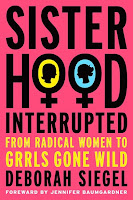 It happens every time this year. The pile of books that publishers have sent me unsolicited in the hopes for a review stares me in the face, creating a sense of guilt. Though I know that all publicists send books out widely as part of their general marketing strategy, I always feel, well, bad if we don’t end up reviewing a book that nevertheless looks fantastic. The book just sits on my shelf.
It happens every time this year. The pile of books that publishers have sent me unsolicited in the hopes for a review stares me in the face, creating a sense of guilt. Though I know that all publicists send books out widely as part of their general marketing strategy, I always feel, well, bad if we don’t end up reviewing a book that nevertheless looks fantastic. The book just sits on my shelf.
So in the interest of clearing my slate, and easing my guilt (oy), I’ve decided to do something different this year.
Below is the list of those books on my shelf MOST itching for a review. If any GWP readers (in the US due to postage expense, sorry!) would like to review one, I’ll send my copy out to the first person who requests it. You can email me at deborah@girlwpen.com and state the title of your preference in the subject header. These reviews will be “due” by the end of January, and I’m asking that they be short ‘n snazzy (700 words or less).
It’s a great opportunity for anyone who has wanted to submit a guest post this year but haven’t yet to start off 2009 with a bang! Ok, so here’s the list:
Isadora Duncan: A Graphic Biography by Sabrina Jones
The Third Chapter: Passion, Risk, and Adventure in the 25 Years After 50, by Sara Lawrence-Lightfoot
34 Million Friends, by Jane Roberts
And a book I’ve mentioned here a few times but didn’t get a chance to give it the review it deserves:
Ready: Why Women Are Embracing the New Later Motherhood, by Elizabeth Gregory (a very personal subject over here right about now, ahem!)
Lastly, ANY book put out this season (or next!) by the publisher who put out Sisterhood, Interrupted — Palgrave Macmillan. You can find that list here.
And speaking of GWP reviews, do keep a look out soon for Elline Lipkin’s review of Mama, PhD: Women Write About Motherhood and Academic Life! It’s been the hopper for a while but is coming soon, we promise. A personal aside: As a PhD and an aspiring Mama, of course I loved this one.

 Sad times over here in the publishing world. The news reports come one after another: layoffs at
Sad times over here in the publishing world. The news reports come one after another: layoffs at  I’m pleased to bring you
I’m pleased to bring you  This here’s an open call for reviews of the following, to be published here on GWP:
This here’s an open call for reviews of the following, to be published here on GWP: From Sarah Palin’s wardrobe to sex on college campuses…Hmm, not sure how to make the transition here, so I won’t try. But I’ve been wanting to share this list of some of the latest on the college kids and the sex. A couple of my brilliant colleagues at the
From Sarah Palin’s wardrobe to sex on college campuses…Hmm, not sure how to make the transition here, so I won’t try. But I’ve been wanting to share this list of some of the latest on the college kids and the sex. A couple of my brilliant colleagues at the  Just a quick hit today on a book I’m about to get my hands on, titled
Just a quick hit today on a book I’m about to get my hands on, titled 


